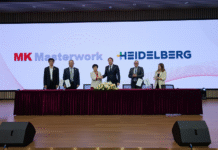
The Gallus Labelmaster is a label printing press platform designed for the label and packaging market. It features a special platform design and can be configured by customers to meet their own specific requirements. With its open interfaces and Heidelberg platform development know-how for offset presses of Heidelberg, this machine represents a highly secure investment and enables users to respond flexibly to future changes in the market. The Labelmaster 440 thus builds on the successful, tried-and-tested design principle of Speedmaster offset printing presses from Heidelberg.
Developing a new platform for the label market
“Gallus and Heidelberg have harnessed a great many synergies in developing the new platform technology for the label market. Modular design and reduction in complexity benefit both sets of customers—sheetfed and label market—and make them more competitive,” said Stephan Plenz, member of the Heidelberg Management Board responsible for equipment. The Gallus Labelmaster augments the existing digital label printing portfolio—also developed in collaboration with Heidelberg and based on the Gallus Labelfire 340—with a solution for high-quality packaging and label applications. Other, wider web widths will follow as development of the machine system continues. A Gallus customer in Europe is currently putting the first press through its paces in an intensive field test programme and the first series deliveries are scheduled for the second quarter of next year.
Basic, Plus and Advanced modules
In the new platform system, the Gallus Labelmaster is made up of modules that each comprise two printing units. These modules are available in three different variants. The ‘Basic’ version covers all the required standards of the label printing; the ‘Plus’ version allows greater flexibility; and the ‘Advanced’ version is configurable for all needs in the level of automation. By opting for a modular system, Gallus is ensuring that label printers can satisfy prevailing market requirements and stay fit for the future at all times. And this for investment sums that were not previously possible for premium products. Christof Naier, vice president – sales and service (Label Business) and member of executive committee, Gallus Ferdinand Ruesch AG said, “This new product will offer our customers a price-performance ratio which has not been seen before.”

This modularity is made possible by, among other things, a new locking system that makes it easy to change printing units accurately. The system positions the printing units on the base unit with precision and locks them in place, thus ensuring 100% register accuracy from the moment the press is started, regardless of what substrate is chosen. The press is designed to support a wide range of substrates, from paper and PE to PP and foil.
The developers at Gallus have also introduced a special feature to make operating the Gallus Labelmaster a user-friendly experience. The Gallus engineers have tried to ensure that the press is simple and fast to operate across all sectors. The press can be controlled centrally via an HMI touch panel, although manual intervention is also supported, with operators able to make changes with ease and, more importantly, very quickly, thereby achieving short set-up times. The lightweight aluminium printing cylinders that have been specially developed for this machine type can be changed in just a few quick steps, thus ensuring that job changes can be completed with speed.
However, it is not just set-up processes that have been speeded up—the high printing speeds of up to 200 m a minute on the press ensure operational cost-efficiency with register accuracy. A short web path of just 1.1 m from printing unit to printing unit significantly reduces waste and an optimized ink duct for the chambered doctor blade needs just 250 gm of ink and therefore keeps the associated costs low. The ink duct has also been improved in ink spitting and foaming. The newly designed flexographic printing unit is driven directly by two servomotors. Besides being fitted out with flexographic printing units, the press can also be equipped with a newly developed screen printing unit that enables users to make the most of high-end finishing options.
The register accuracy of the Gallus Labelmaster is also impressive as demonstrated. Whether the press is running at a low set-up speed or being accelerated to a high maximum speed, the printed images do a good register, without any major correction necessary. Three jobs were performed during the demonstration which were completed within 10 minutes with only the printing cylinders changed as per the job requirements. Klaus Bachstein, chief executive officer, Gallus Group said, “We wanted to build a new machine which can be configured and grows with the customer. I think, this is a machine which uses our and Heidelberg’s experience and know-how very well. The introduction of this machine and its future course will help make our portfolio complete.”
Heidelberg and Gallus: A one-stop shopping point
Ferdinand Ruesch, former owner of Gallus and anchor investor in Heidelberger Druckmaschinen AG said, “This is a press which has not only required intensive discussions in-house but we also spoke to various customers in Europe as well as in emerging economies such as China and India to understand the key requirements and needs. We are pretty optimistic that this new press will hit the right notes with our customers. The reason why Heidelberg associated with Gallus is because together, with our combined portfolios, we can meet each and every requirement of a customer—whether he is a label printer, a converter or a sheetfed printer. In brief, we have all the solutions he needs. If the printer makes money out of the machine he purchases, we too make money at the end of the day. We have truly become a one-stop shopping point for our customers.”
Indian label printer at Gallus Innovation Days
Manish Desai of Mumbai-based Mudrika Labels was one of the Indian printers who attended the Gallus Innovation Days. Mudrika Labels is a label printer which is using Gallus label presses for quite some time now and has several EM 280 as well as ECS 340 presses running in its facilities. Although we met Desai at the hotel before he saw the prototype of the new press, he was happy with the decision of Gallus to increase width size to a more flexible 440 mm. Gallus has claimed a never-before price to performance aspect of this new press, which seemed to have also caught Desai’s attention. He said, “As far as my understanding goes, this new press is still not quite ready for production. However, when it
will be ready, I shall certainly contemplate it and see whether it fits my production plans.”









